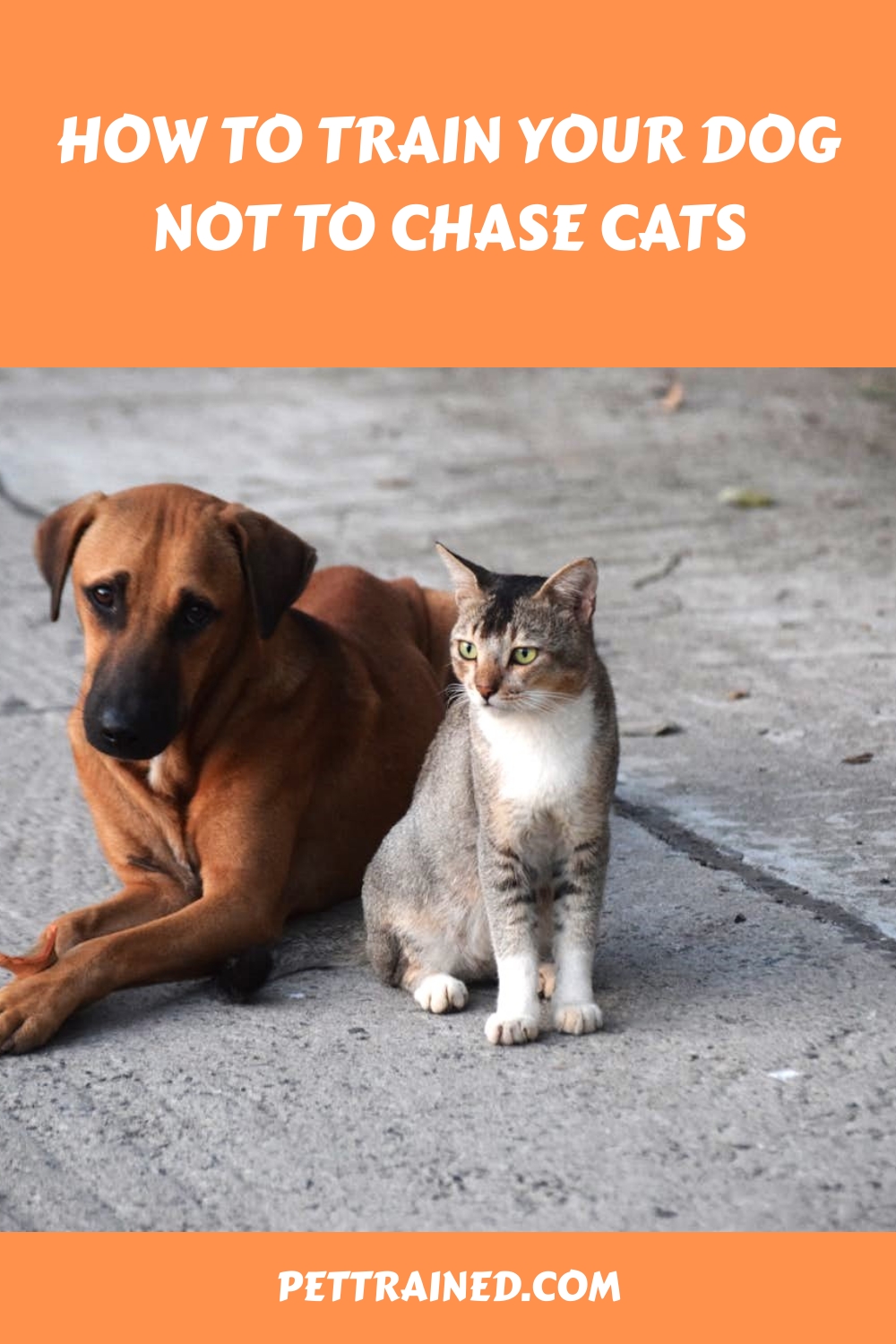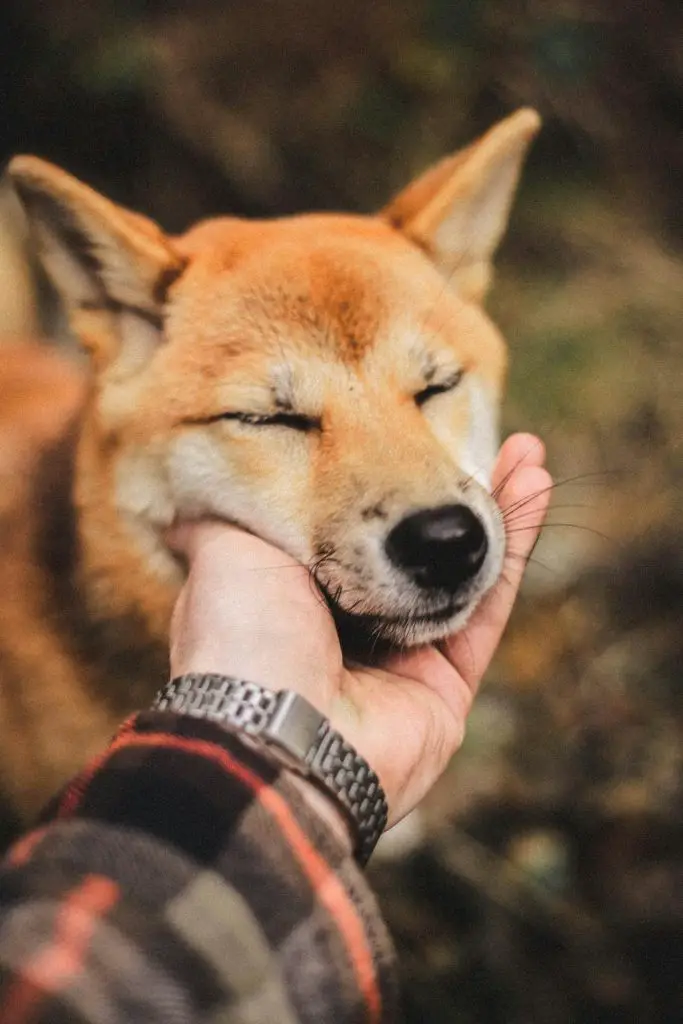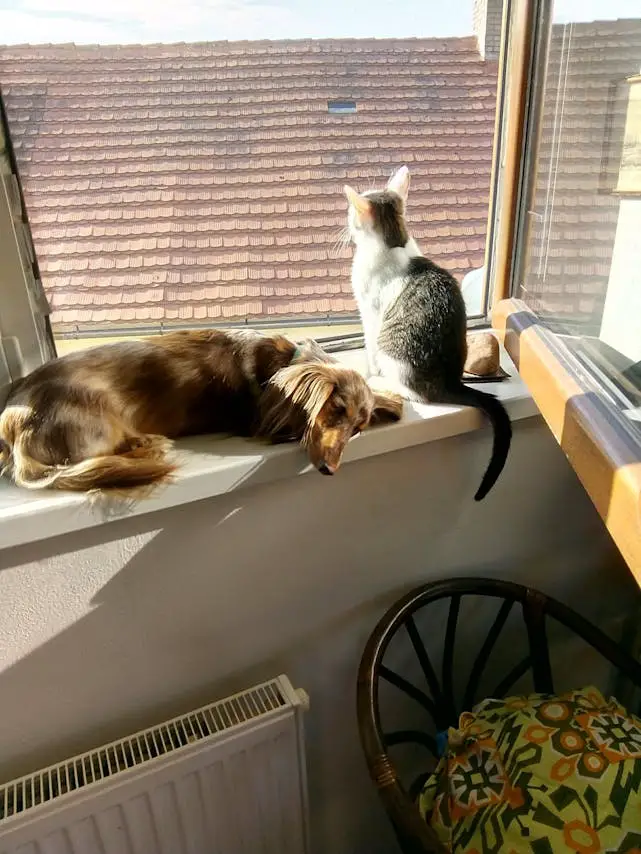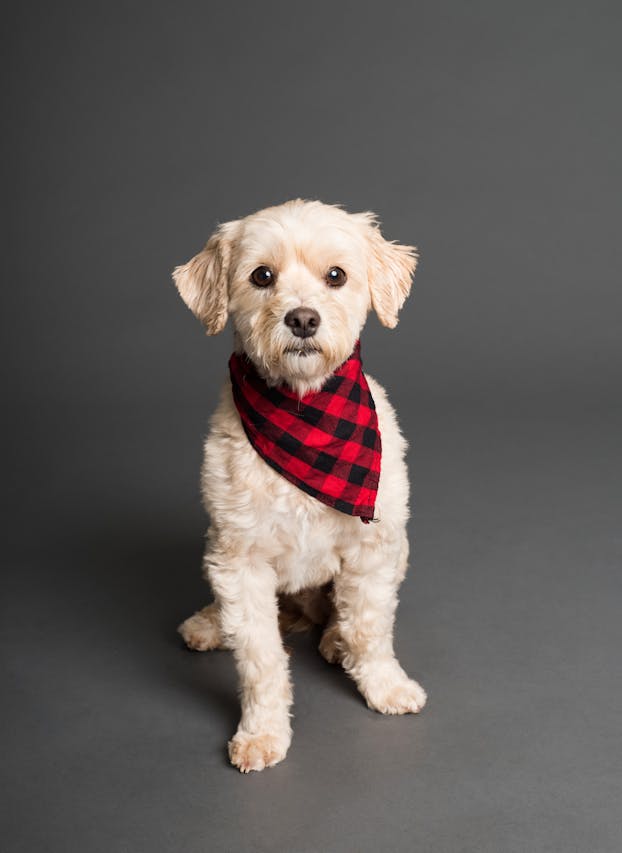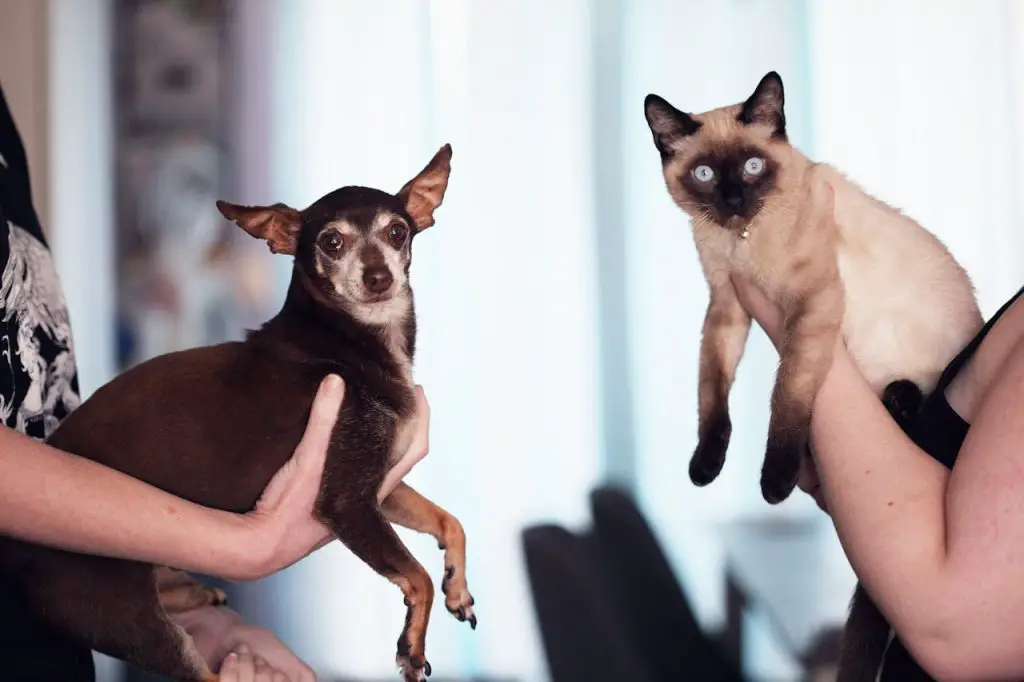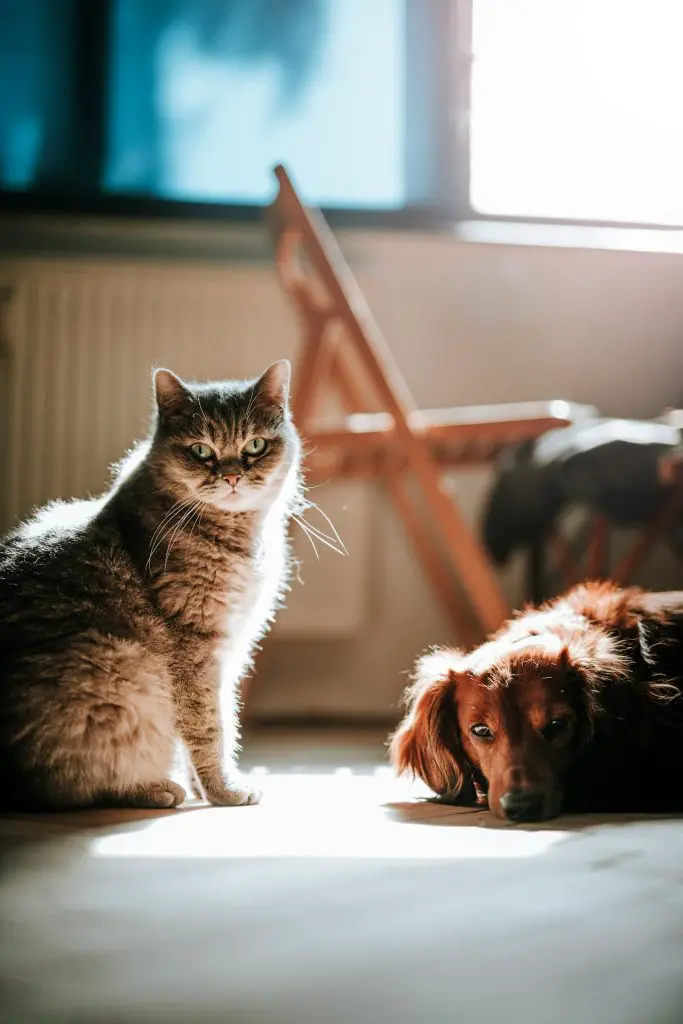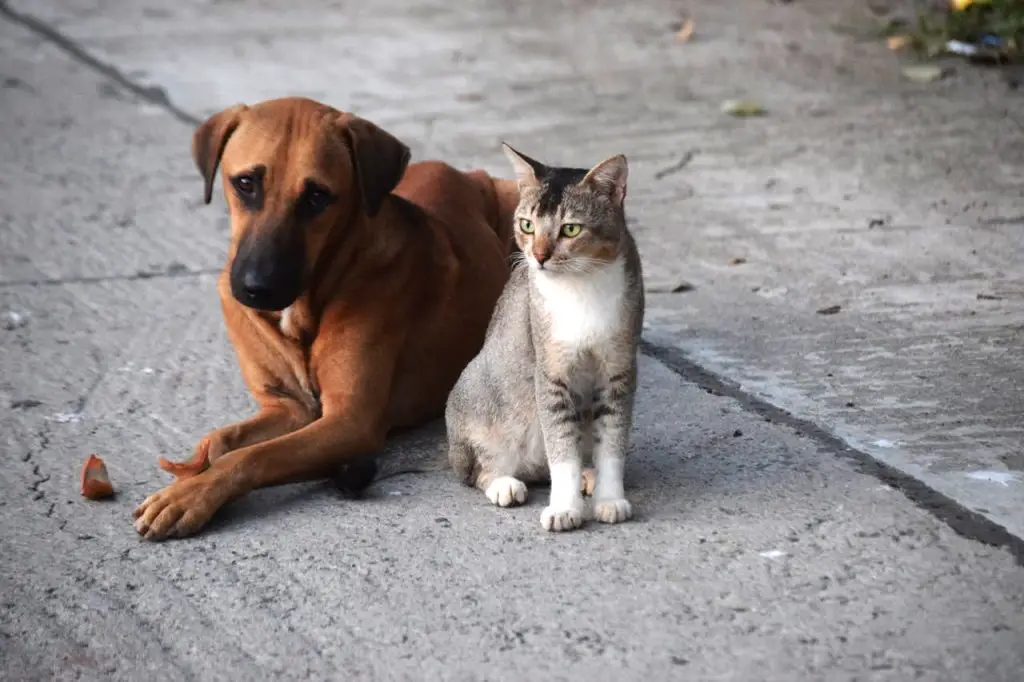
To train your dog not to chase cats, start by understanding their natural chase instinct. Create separate, secure spaces for each pet to relax and introduce them gradually while your dog is leashed.
Use positive reinforcement to reward calm behavior around cats with treats and praise. Teach basic commands like ‘sit,’ ‘stay,’ and ‘leave it’ to manage interactions effectively.
Consistent, brief training sessions will reinforce the desired behaviors. Always supervise interactions initially, and remain patient, as progress may be slow.
With a structured approach, you’ll create a peaceful coexistence between your dog and cats. Discover more techniques to cultivate harmony at home.
Table of Contents
Key Takeaways
- Reward calm behavior around cats with treats, praise, and playtime to discourage chasing.
- Create designated pet zones with secure barriers and safe spaces to reduce stress.
- Use basic commands like ‘sit,’ ‘stay,’ ‘come,’ and ‘leave it’ to manage interactions.
- Gradually introduce cats and dogs with supervised, leashed interactions to build comfort.
Understanding Your Dog’s Instincts
Why do dogs have a natural inclination to chase cats?
This post contains affiliate links. However all the information provided on this site are my own honest opinions. See more in Disclaimer.
It all boils down to dog instincts and feline behavior. Dogs are natural predators, and their ancestors relied on hunting to survive. This ingrained predatory drive can manifest as chasing small, fast-moving creatures like cats.

Your dog’s instinct isn’t about malice; it’s simply a deep-seated behavior pattern. Understanding dog instincts is essential for addressing this issue.
Dogs have an innate drive to pursue moving objects, which includes cats, squirrels, and even toys.
This drive can be traced back to their wolf ancestors, who needed to chase prey to eat. When your dog spots a cat darting across the yard, its predatory instincts kick in, compelling it to give chase.
On the other hand, feline behavior plays a significant role too. Cats are naturally wary and quick to flee from perceived threats. This flight response can trigger your dog’s chase instinct.
Recognizing these behaviors and understanding the natural tendencies of both animals will help you create a more harmonious environment.
By addressing these instincts, you’ll be better equipped to train your dog to coexist peacefully with cats.
Setting Up a Safe Space
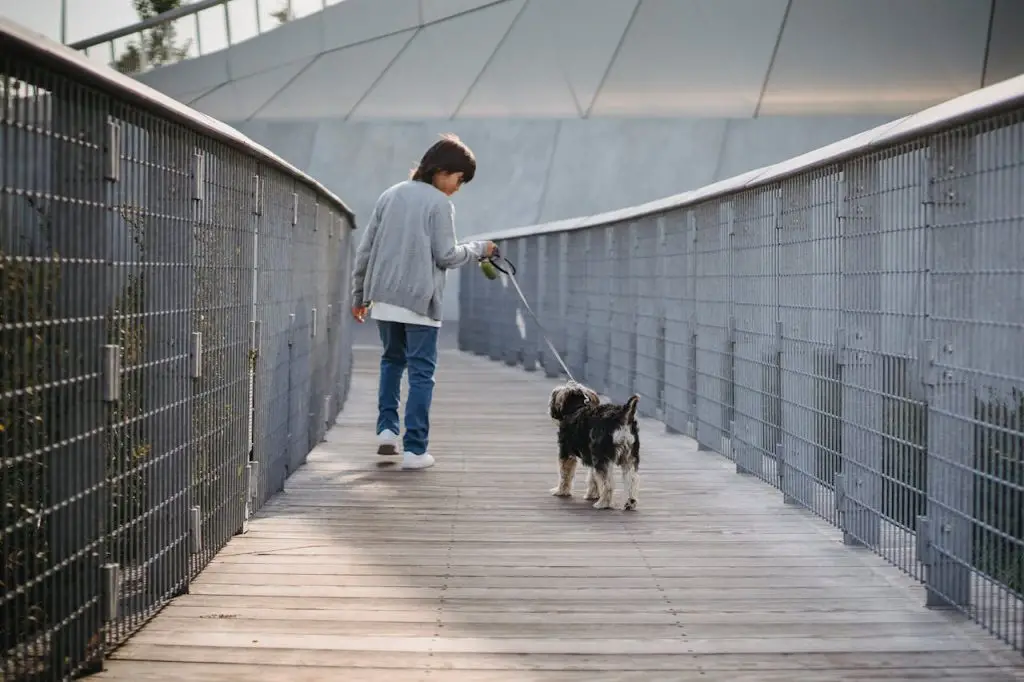
To guarantee your cat feels secure, start by creating designated pet zones where they can retreat without interference.
Use secure barriers to separate these areas and maintain harmony.
Make certain these zones are comfortable and easily accessible for your cat.
Designated Pet Zones
Creating designated pet zones is essential to providing both your dog and cat with safe spaces where they can retreat and feel secure.

These zones offer numerous pet zone benefits, helping to reduce stress and prevent unwanted behaviors like chasing. By creating these areas, you guarantee your cat has a refuge and your dog understands boundaries.
Here are some steps to set up effective pet zones:
- Identify Separate Areas: Choose distinct areas in your home for your dog and cat. This makes it clear where each pet can relax without interference.
- Use Comforting Items: Equip each zone with familiar items. For your dog, this might include their bed and favorite toys. For your cat, consider a cozy bed, scratching post, and some toys.
- Guarantee Accessibility: Make sure your cat’s zone is easily accessible to them but harder for your dog to reach. High perches or gated areas work well.
- Monitor Interaction: Initially supervise interactions between your pets to reinforce the idea that these zones are off-limits to the other.
Secure Barriers Placement
Setting up secure barriers is the next step to guarantee your pets have distinct, safe spaces where they can coexist peacefully. Start by identifying the areas where your dog and cat need to be separated.

For outdoor spaces, fence installation is vital. Choose sturdy barrier materials like wood, metal, or vinyl to assure durability.
Make sure the fence is high enough to prevent your dog from jumping over and secure enough at the base to stop digging.
Indoors, baby gates are a great option. Install these gates in doorways to create pet-free zones.
Opt for gates with vertical bars to prevent climbing and confirm the latch mechanism is strong enough to withstand your dog’s attempts to push through.
For smaller spaces, consider using pet pens or playpens as temporary barriers. When placing barriers, think about your pets’ comfort and safety.
Confirm there are no sharp edges or loose parts that could cause injury.
Additionally, make sure your cat has an escape route, like a high perch or a separate room. By carefully selecting and installing the right barriers, you’ll foster a safe and harmonious environment for both your dog and cat.
Comfort and Accessibility
Ensuring your pets are comfortable and have easy access to their safe spaces is essential for reducing stress and preventing unwanted chasing behaviors.

When dogs and cats feel secure, they’re less likely to display anxiety-driven actions.
Here’s how you can set up these areas effectively:
- Designate Separate Zones: Create distinct spaces for your dog and cat. This helps reduce dog anxiety and prevents your cat from feeling threatened. Use baby gates or pet barriers to establish these zones.
- Comfortable Bedding: Provide cozy beds in your pet’s designated area. Soft, familiar bedding can greatly reduce stress. It encourages your pets to retreat to their safe spaces when needed.
- Accessible Hideaways: Cats especially need places to hide. Consider cat trees, shelves, or covered pet beds. These hideaways cater to feline behavior, offering them a sense of security.
- Calming Aids: Utilize calming aids like pheromone diffusers or anxiety wraps. These tools can help mitigate dog anxiety. They create a more peaceful environment for both pets.
Using Positive Reinforcement
To effectively train your dog not to chase cats, focus on using positive reinforcement. Reward your dog when they remain calm around cats.
Guarantee training sessions are consistent. Use treats wisely to reinforce good behavior.
Build a positive association with staying composed.
Reward Calm Behavior
Rewarding your dog for calm behavior around cats is essential for reinforcing positive interactions. Start by creating a calm environment where your dog and cat can coexist without stress.
Observe your dog’s reactions closely when the cat is present.
If your dog remains calm, it’s time to reward that behavior immediately. Here’s how you can do it effectively:
- Treats: Use high-value treats that your dog loves. When your dog is calm around the cat, give a treat right away to reinforce that calm behavior.
- Praise: Verbal praise works wonders. Use a soothing tone to let your dog know you’re pleased with their calm demeanor.
- Petting: Gentle petting can be a powerful reward. Stroke your dog slowly and gently when they remain calm around the cat.
- Playtime: If your dog enjoys playing, use this as a reward for calm behavior. Engage in a favorite game or activity to encourage positive associations.
Consistent Training Sessions
Consistency is key when training your dog not to chase cats, so establish regular training sessions using positive reinforcement techniques.
Set up a training schedule that you can stick to, ideally with short, daily sessions. This helps create a routine that your dog can depend on, making the training process smoother and more effective.
Begin each session by focusing on calm behaviors and rewarding your dog when they display them. Keep sessions engaging yet not too long to prevent your dog from becoming tired or frustrated.
Use positive reinforcement, such as verbal praise or petting, to encourage desired behaviors.
Behavioral tracking is essential to monitor your dog’s progress. Keep a log of each training session, noting specific behaviors and improvements.
This helps you identify patterns and adjust your training methods as needed.
Remember, patience is vital. Some dogs may take longer to learn not to chase cats, and that’s perfectly okay. Celebrate small victories and stay committed to your training schedule.
With consistent effort and positive reinforcement, you’ll help your dog develop the self-control needed to coexist peacefully with cats.
\Your dedication and compassion make all the difference in your dog’s learning journey.
Use Treats Wisely
When using treats as positive reinforcement, make sure they’re high-value and given immediately to reinforce the desired behavior effectively.
Treat selection is essential; choose something your dog finds irresistible.
Timing rewards is just as important—delivering the treat at the right moment helps your dog understand what specific behavior is being rewarded.
Here’s a quick guide to help you use treats wisely:
- Choose High-Value Treats: Select treats that your dog doesn’t get every day. Think small pieces of cooked chicken or special store-bought dog treats that are only used during training.
- Immediate Rewards: Give the treat within two seconds of the desired behavior. This helps your dog make the connection between the action and the reward.
- Consistency: Use the same type of treat and timing each time. This creates a predictable pattern that your dog can understand and rely on.
- Gradual Reduction: Once your dog consistently responds correctly, start to reduce the frequency of treats. Replace them with verbal praise or petting to maintain the behavior without always needing a treat.
Teaching Basic Commands
Mastering basic commands is fundamental in training your dog not to chase cats. Obedience training forms the backbone of effective command recognition, which is critical for guaranteeing your dog responds promptly and consistently.

Start with basic commands like ‘sit,’ ‘stay,’ and ‘come.’ These commands create a foundation of discipline and control, making it easier to manage your dog’s behavior around cats.
Begin by using positive reinforcement. When your dog successfully follows a command, reward them with a treat or praise. This reinforces the behavior and encourages repetition.
Consistency is key; practice these commands daily in various environments to verify your dog understands and obeys regardless of distractions.
Commands like ‘leave it‘ and ‘focus‘ are particularly useful. ‘Leave it’ instructs your dog to ignore the cat, while ‘focus’ redirects their attention to you.
Practice these commands frequently, gradually increasing the level of distraction. Remember, patience and persistence are essential.
Dogs learn at their own pace, and rushing the process can lead to setbacks.
Gradual Cat Introductions
Introducing your dog to a cat should be done gradually and in a controlled environment to assure both animals feel safe and secure.
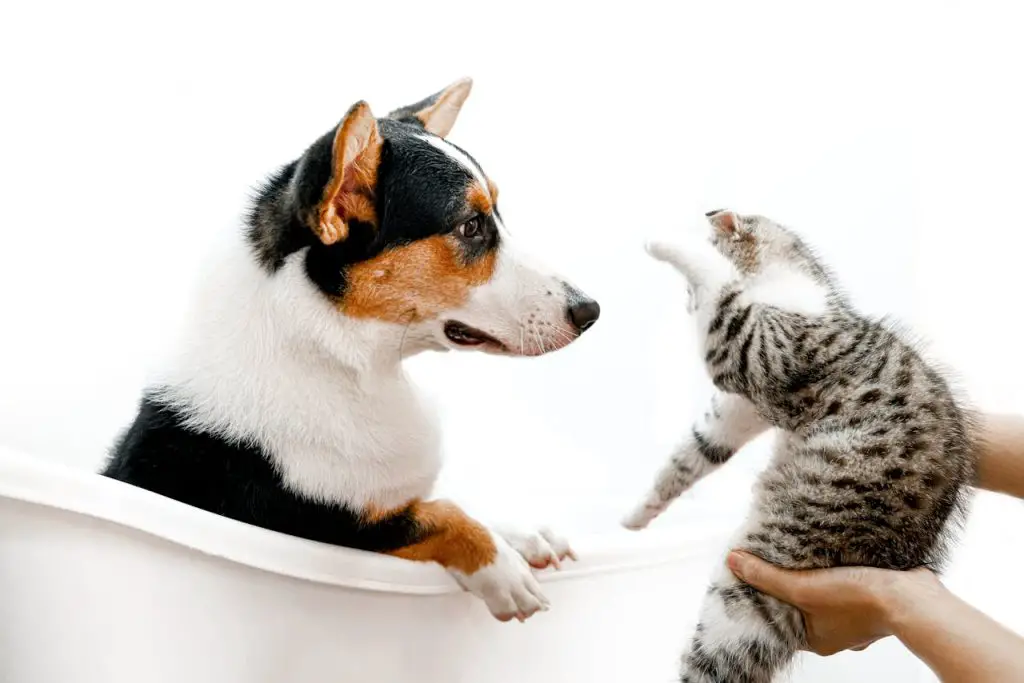
Understanding cat behavior and using leash training for your dog will create a smoother introduction process.
Here’s a step-by-step guide to help you:
- Separate Spaces: Begin by allowing your cat and dog to get used to each other’s scent. Keep them in separate rooms and swap bedding or toys between them. This will help both animals become familiar with each other’s presence without direct contact.
- Leash Training: Confirm your dog is comfortable on a leash. Practice obedience commands like ‘sit’ and ‘stay’ to maintain control during introductions. A calm dog on a leash will reduce stress for your cat.
- Short Introductions: Start with brief, supervised sessions where your dog is on a leash and your cat can observe from a safe distance. Keep these interactions positive by rewarding both animals with treats and praise.
- Increase Duration Gradually: Gradually lengthen these sessions as both animals show signs of relaxation and curiosity instead of fear or aggression. Always prioritize their comfort and never force interactions.
Supervised Interactions
Supervised interactions between your dog and cat are essential for ensuring a safe and harmonious relationship. Start by keeping both animals on a leash or in separate, controlled spaces.
This allows you to manage their behavior and intervene if necessary.
Pay close attention to cat behavior, as cats often signal discomfort through body language like hissing, puffing up, or swishing their tails.
Use positive reinforcement training techniques to encourage calm behavior. Reward your dog with treats and praise when they remain relaxed around the cat.
If your dog shows signs of chasing, such as intense staring or lunging, redirect their attention with a toy or command. Be consistent with this approach to help your dog understand what’s expected.
It’s also important to create safe spaces for your cat. High perches or gated areas where the dog can’t reach provide your cat with escape routes. This reduces stress and gives your cat control over their environment.
Consistency and Patience
Consistency and patience are essential when training your dog not to chase cats, as these qualities help reinforce desired behaviors over time.
Your dog needs clear, consistent signals to understand what’s expected. Patience guarantees you give your dog the time needed to internalize these new behaviors.
Here’s how you can maintain consistency and patience in your training techniques:
- Daily Training: Make training a daily routine. Consistent practice helps solidify the connection between commands and expected behavior.
- Uniform Commands: Use the same commands and signals every time. Mixed messages can confuse your dog and slow down the learning process.
- Positive Reinforcement: Reward good dog behavior immediately. Positive reinforcement, like treats or praise, encourages your dog to repeat the desired behavior.
- Controlled Environment: Start training in a controlled environment to minimize distractions. Gradually introduce more complex situations as your dog becomes more reliable.
Training a dog not to chase cats can be challenging, but your consistency and patience will pay off. Remember, each dog learns at their own pace.
Stay calm and supportive, and your dog will eventually understand that chasing cats isn’t acceptable.
Frequently Asked Questions

If your dog chases a cat during a walk, immediately use leash training to regain control. Employ distraction techniques like treats or favorite toys to redirect attention. Reward calm behavior, reinforcing positive responses compassionately.
Yes, some breeds have stronger chase tendencies due to their breed characteristics and feline instincts. Breeds like Greyhounds, Terriers, and Herding dogs are more prone to chasing cats. Understanding your dog’s instincts helps manage their behavior.
Training techniques and behavior modification can take several weeks to months. Consistency is key. Every dog is different, so progress varies. Be patient, use positive reinforcement, and don’t get discouraged. Your efforts will pay off.
Did you know 90% of dogs show improvement with professional trainers? They use specialized training techniques and behavioral modification to effectively stop undesirable behaviors. You’ll find their expertise invaluable in creating a harmonious home for your pets.
Yes, you can use deterrent collars or ultrasonic devices to prevent your dog from chasing cats. These tools emit unpleasant sounds or sensations, discouraging the behavior. Always combine them with positive reinforcement for the best results.
Conclusion
You’ve got this! By understanding your dog’s instincts and setting up a safe space, you’re already halfway there.
Using positive reinforcement and teaching basic commands will work wonders. As you gradually introduce your cat, those supervised interactions will become smoother.
Remember, consistency and patience are key. It’s no coincidence that with your dedication, your dog will learn to coexist peacefully with your cat.
You both deserve a happy, harmonious home. Keep at it!
